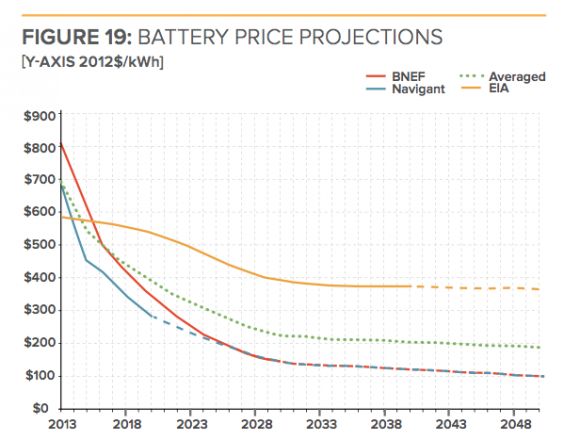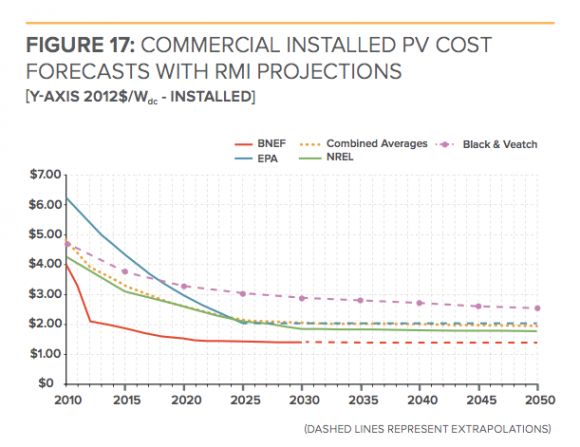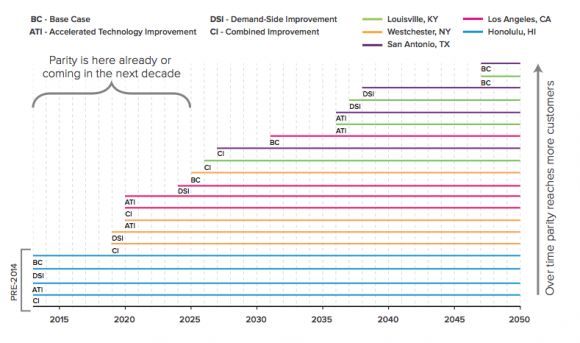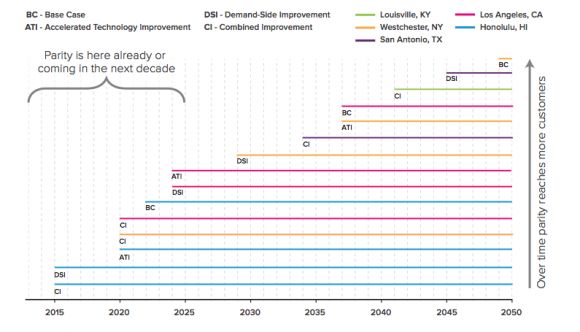In October 2012, as Superstorm Sandy rocked the East Coast, 75 residents gathered in the Midtown Community School in Bayonne, New Jersey.
The elementary school was operating as an emergency shelter, giving people who were stuck in the severely flooded town a place to stay dry. But the school was much more than a shelter -- it was an experiment in hybrid solar photovoltaics that may herald a coming structural change in the power sector.
Four years earlier, the local school district approached the New Jersey-based installer Advanced Solar Products, which had already developed a 272-kilowatt system for the Midtown school. The school district wanted to figure out how to allow the solar PV to operate during power outages when other systems were required to shut off. The company worked with SMA to modify a commercial inverter and tie it into the emergency diesel generator, allowing the generator to idle at low levels when the sun was shining.
The result was a steep drop in fuel consumption at a time when it was nearly impossible to make diesel deliveries to flood-stricken areas.
"The solar did what it was supposed to do. It worked exactly as planned," said Lyle Rawlings, president of Advanced Solar Products, in an interview.
Although the system was a custom job, making it fairly expensive, Rawlings says his company took the experience to heart. Advanced Solar Products is now working with other commercial facilities to integrate lithium-ion batteries with solar, and plans to make solar-storage systems a bigger part of the business going forward.
"We see this as a thing that's going to develop more and more, and we want to take the lead in development," said Rawlings.
And it's not just emergency backup that makes storage attractive. Now that fast-responding systems like flywheels and lithium-ion batteries can get paid for frequency regulation services in PJM or help reduce onsite demand charges for commercial facilities, storage is emerging as a viable economic alternative.
In one case, Advanced Solar Products was able to pay for a commercial storage system and inverter through frequency regulation payments -- actually making the cost of a hybrid solar-storage system lower than solar alone.
"That, to us, seemed magical, and it told us we could provide this service for a low cost," said Rawlings.
Now that storage is moving beyond simple emergency applications, that "magical" alternative -- while still very site- and market-specific -- is emerging as a potential threat to utilities.
Driven by market changes that reward storage, improving system economics and third-party financing tools, the nascent distributed storage market is on the upswing in the U.S. Witnessing these changes, the country's leading solar installer, SolarCity, has started offering solar paired with storage to commercial customers. And distributed storage providers such as Solar Grid Storage, Stem, Intelligent Generation and Green Charge Networks are reaching out to solar developers to form partnerships.
A recent GTM Research report projected that the U.S. commercial storage market could grow to more than 720 megawatts by the end of the decade. Some of that growth will come directly from a closer relationship with the solar industry.
So what does this mean for the power sector's future?
The Rocky Mountain Institute, CohnReznick and HOMER Energy attempted to answer that question in a new report released yesterday. The analysis looks at the economics of storage-solar systems in the commercial and residential sectors, and projects when mass adoption may start to occur in key markets.
The conclusion: the combination of solar and storage is a "real, near, and present" threat to the way utilities do business.
"The coming grid parity of solar-plus-battery systems in the foreseeable future, among other factors, signals the eventual demise of traditional utility business models," wrote the authors.
Using modeling software from Homer Energy and electricity data from the Energy Information Administration, the analysts looked at a range of technology scenarios in the commercial sector for solar, lithium-ion batteries, and generators working together. In the residential sector, the analysts looked just at solar and batteries.
On their own, the economics of the two technologies are improving steadily. According to the Department of Energy, lithium-ion battery costs have dropped by 50 percent since 2008. And prices could drop as low as $125 per kilowatt-hour in the coming decades. Tesla founder Elon Musk thinks they could drop to as low as $200 per kilowatt-hour in the next few years.
There's been an equivalent drop in residential and commercial solar. According to GTM Research, the average price of an installed solar system (weighted across all sectors) has fallen by 61 percent since the first quarter of 2010.
The RMI/CohnReznick analysis shows a range of other projections for cost forecasts, which illustrate an equally steady decline in the coming decades. Those cost reductions, driven by better hardware, lower module prices, efficient installation techniques and scale, are helping to further drive down system prices.

But what about the combination of the two technologies? Adding storage will increase the cost of a solar system. Although those costs can be addressed by leveraging storage to reduce on-site demand charges or participate in frequency regulation where allowed, the economics vary widely based upon the region.
The analysis looked at five cities: Honolulu, Hawaii; Los Angeles, California; Louisville, Kentucky; San Antonio, Texas; and Westchester, New York.
Under a base-case scenario, which simply factors in existing technologies and market constructs, the authors argue that the combination is only truly competitive in Hawaii, where oil-based generation is extremely expensive. (However, as the previously mentioned case from New Jersey shows, the technology can be competitive at specific sites in other markets.)
Under a more aggressive scenario, which factors in strong technology improvements and deeper use of intelligent efficiency, solar and storage together become competitive much sooner in a broader range of markets -- even becoming a strong alternative in a coal-based state like Kentucky, where electricity prices are relatively low.

Competitiveness in the residential sector will occur later, but there are still opportunities for grid parity by the end of the decade -- or even today -- in several markets.

The timing outlined in the report varies widely depending on a number of technological and market-based factors. But even under the most conservative scenario, the authors conclude that solar and storage together have the potential to massively erode utility revenue.
In the Southeast and Mid-Atlantic markets, these technologies could be less expensive than one-fifth of load by 2024 with no dramatic improvements. That means more than 1.2 million customers in those regions may have the opportunity to virtually disconnect from the power company. Under a more advanced scenario, utilities in those regions could be at risk of losing their traditional relationship with millions more customers.
"In the Southwest, as many as 20 million residential customers could find economic advantage by 2024 with solar-plus-battery systems under our combined improvement scenario. In the Mid-Atlantic, roughly 8 million customers will find favorable economics for solar-plus-battery hybrid systems by 2024 given the same combined improvements. Between the two geographies, this represents over $34 billion in annual utility revenues," wrote the authors.
Earlier this month, former Duke Energy CEO called the power grid a "blank sheet of paper" and predicted that most power plants will need to be replaced by the middle of the century.
"One of the big challenges as we redesign the generation fleet in this country is [figuring out] what this mix will be," Rogers said.
Even with no dramatic changes, the RMI/CohnReznick analysis shows that solar and storage together will be competitive in most regions of the U.S. by 2050. Assuming most of the country's centralized power plants need to be replaced by that time, the relationship between utilities and their customers will be irreversibly changed as more people invest in hybrid systems.
"Utilities operate on a long time horizon, and concerns about grid defection should be creeping toward the forefront of utilities' minds now," said Shayle Kann, senior VP of GTM Research. "In addition, this should be a prime factor in utility considerations regarding changes to net energy metering programs. The more utilities move toward rate structures that impose fixed charges which cannot be reduced through net metering, the greater the incentive for customers to defect."
Utilities are currently worried about what solar may do to revenues, and are working to change net metering policies in order to account for grid costs. But that may only be a short-term fix. If storage continues to gain traction as a viable partner to solar, customers may still have the opportunity to loosen or break ties with their power company.
"Millions of customers...representing billions of dollars in utility revenues will find themselves in a position to cost-effectively defect from the grid if they so choose," concluded the report authors.



